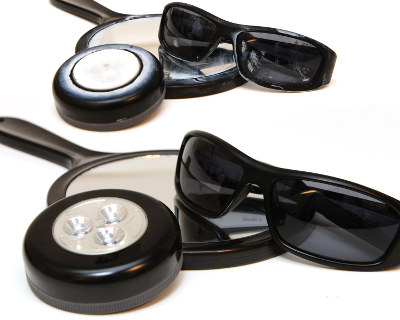 |
| July 23, 2013 | Volume 09 Issue 28 |
Designfax weekly eMagazine
Archives
Partners
Manufacturing Center
Product Spotlight
Modern Applications News
Metalworking Ideas For
Today's Job Shops
Tooling and Production
Strategies for large
metalworking plants
Assembly snapshot:
Controlling blooming or frosting when using instant adhesives
For bonding applications where aesthetics are critical, nine ways to reduce and even eliminate the white haze that can form around cyanoacrylate bond lines.
By Josh Sherwood, OEM Market Manager, Henkel Corporation

Items in the rear of this photo are covered with blooming or frosting from regular instant adhesives, while items in the front of the photo are clean and bloom-free using low-odor/low-bloom instant adhesives. [Image: Henkel Corp. (Loctite)]
Cyanoacrylates (CAs) are one-part instant adhesives that fixture rapidly and cure at room temperature. These adhesives bond a wide range of components, providing excellent adhesion to metals, plastics, elastomers, and porous substrates.
Cyanoacrylates polymerize on exposure to water, a weak base that is present in trace amounts on virtually all surfaces. Acidic stabilizers present in the adhesive are neutralized by this weak base, initiating rapid cure. These adhesives achieve fixture strength in just seconds and full strength within 24 hr.
As a technology, CAs are very easy to use and automate. These dry, colorless adhesives bond well to a variety of substrates, fixture rapidly, and deliver high-strength bonds when fully cured. For the manufacturer, their cure speed increases throughput and reduces per piece processing costs.
But CAs are prone to blooming or frosting, a cosmetically unappealing phenomenon that manifests itself as a rainbow or whitish haze surrounding the bond line. Blooming occurs when unreacted cyanoacrylate monomers volatilize from the surface of the dispensed adhesive and become airborne. Since these molecules are heavier than air, they tend to fall back onto the surface of the part outside the bond line in the form of white flakes. In great numbers, these flakes create a hazy or frosted appearance on the part.
The rainbow haze is due to a small concentration of cyanoacrylate particles on the surface. Light hitting the surface is diffracted, causing the rainbow effect. The whitish haze surrounding the rainbow is due to a relatively higher concentration of cyanoacrylate monomer.
Blooming has no negative effects on the strength and durability of the bond. While blooming is desired in some CA applications (such as fingerprint detection), this purely aesthetic problem is viewed as a detriment in applications where a clean bond line is critical, for example on cosmetic cases, medical equipment, electronic devices, pharmaceutical packages, appliances, automotive parts, and speakers.
Reducing the potential for blooming
There are a number of ways to reduce or eliminate the potential for blooming or frosting of instant adhesives.
1. Low-odor, low-bloom instant adhesives. These adhesives are formulated using cyanoacrylate monomers with higher molecular weights than those of traditional CAs. These higher-weight molecules make the adhesive less likely to become airborne than standard cyanoacrylate monomers, reducing both blooming and chemical odors.
2. Flashcure or light-cure cyanoacrylates. These adhesives combine cyanoacrylate and light-cure technology to cure tack-free in less than 5 sec rather than the 30 sec required by regular instant adhesives. This extremely rapid cure eliminates the possibility of blooming because the adhesive never has a chance to become airborne.
3. Avoid large fillets. Fillets are areas along the bond line where adhesive squeezes out or reaches just beyond the edge of the substrate. This provides an ideal opportunity for blooming to occur, as the adhesive is completely exposed to the open air. By keeping the adhesive within the bond line and minimizing substrate-level exposure, less adhesive will be available to become airborne and migrate beyond the bond line.
4. Increase air flow. Avoid assembling parts and immediately placing them in an airtight environment, such as a bag or shipping container. Cross-ventilation helps carry airborne CA molecules away from the bond area, minimizing the number of molecules available to fall back to the bond line area.
5. Use accelerators. The faster the adhesive cures, the lower the chance there will be unreacted cyanoacrylate monomers that become airborne. By adding an accelerator to speed the rate of cure, the chances of frosting are reduced. But cure speed must be carefully managed: The heat generated by too fast a cure may result in a phenomenon similar to frosting where the rapid exothermic reaction drives off unreacted monomer.
6. Avoid acidic surfaces. Acidic surfaces slow down the cyanoacrylate cure mechanism and keep the adhesive uncured longer. When bonding acidic surfaces, either rinse to reduce acidity or choose an adhesive and/or accelerator designed to work under these conditions such as a surface-insensitive instant adhesive.
7. Avoid extremes in relative humidity. If relative humidity is too low, the adhesive will take longer to cure. Similarly, if relative humidity is too high, the curing reaction may occur too quickly and exothermic reaction may allow blooming to occur. Relative humidity of 40 to 80 percent is recommended for cyanoacrylate cure.
8. Avoid extremes in temperature. Elevated temperatures promote the vapor pressure or volatility of the CA monomer, leading to higher vulnerability to blooming. Conversely, lower temperatures slow the reaction mechanism, causing prolonged cure time and opportunity for the CA monomer to become airpborne. A temperature-controlled environment as close to 70 deg F is ideal.
9. Avoid the use of old material. Old product does not cure as quickly as fresh material. And when cure is slowed, there is more opportunity for adhesive particles to become airborne and for blooming to occur.
Find out more about Henkel low-bloom adhesives at www.henkelna.com/industrial/product-search-1554.htm?keywords=&primaryFacet=0000000287.
Published July 2013
Rate this article
View our terms of use and privacy policy
